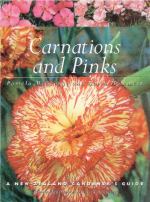 BOOK
REVIEWS BOOK
REVIEWS
Carnations
and Pinks
A New Zealand Gardener's Guide
Pamela McGeorge &
Dr Keith Hammett
David Bateman
$NZ29.95
THE latest in the successful
New Zealand Gardener's Guide series, Carnations and Pinks is
written for local conditions, offering practical advice alongside
beautiful photographs of this enormous family of popular garden
plants.
The text is informative
and authoritative, combining the talents of well-known gardening
writer Pamela McGeorge and leading plant breeder Dr Keith Hammett.
Dr Hammett's sweet peas, dahlias, carnations and pinks have proved
very popular with gardeners here and overseas - his compact, repeat-flowering
pinks are also widely grown in Australia, North America and the
UK.
Carnations and Pinks
details the history of these showy plants, discusses new cultivars
and shows how to display them indoors, with extensive advice on
cultivation, propagation, hybridising, pests, diseases and disorders.
There's a chapter on
carnations as cut flowers which reveals the intriguing history of
how they came to be so popular in the United States (carnations
are the state flower of Ohio).
President McKinley wore
a scarlet carnation in his buttonhole as a talisman during the campaign
that led to his election as US President in 1896. "In 1901, McKinley
attended the Pan-American Exposition in Buffalo, wearing as usual
his scarlet buttonhole. A little girl, in the receiving line to
meet the President, confided to him that her schoolmates would have
trouble believing that he had actually shaken her hand. 'Take my
carnation,' he said, unpinning it from his lapel. 'Show it to them
and they'll know you were telling the truth.' The little girl walked
away with the well-known talisman as the man next in line to greet
the President pulled out a gun and shot him."
This is just one of numerous
fascinating facts included in this useful book. Carnations and
Pinks is a worthy investment for anyone keen to try their hand
at growing dianthus.
Weekend
Gardener, Issue 99, May 23-June 5, 2002, Page 28
Reproduced with permission from the former Weekend Gardener magazine. The views expressed here are not necessarily those of the RNZIH
|
 |
 |
|

